|
|
 |
| My Favourite Planet > Blogs > Cheshire Cat Blog > 2011 |
 |
 |
back |
The Cheshire Cat Blog
 |
 |
November 2011 |
 |
| |
 |

A blackbird sings its heart out on an Athens rooftop TV antenna. |
| |
|
By the time many of you read this it will already be December. That's the way time goes. If you have read the Octember (sic) edition of this blog (click here to read it now), you will understand why the Cheshire Cat currently seems to be caught in a stormy anomaly of the time-space-continuum variety.
Be that as it was, is or may well be, somehow, somewhere along this timeline, the first part of the My Favourite Planet guide to Athens has meanwhile appeared in the form of the Acropolis photo gallery.
So far it's all a bit historical, isn't it? Not to worry, the Cheshire Cat has picked out a few unhistorical - and untypical - photos of Athens which are due to feature in future editions of the guide. |
|
| |
| |
Athens muse |
 |
|
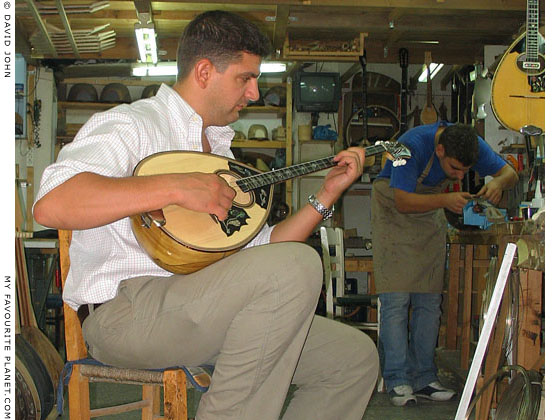
An Athenian musical instrument maker tests a
newly-finished bouzouki in his Psyri workshop.
|
Until recently The Psyri district of Athens, just to the west of Syntagma Square, was a working class area; a warren of narrow streets, crammed with workshops, small businesses and ancient cafes. It is rapidly being gentrified, and trendy new bars, restaurants and clubs are springing up like forest mushrooms - despite the economic crisis.
I recently saw a real estate ad for a tiny old Psyri house, now tastefully renovated, and selling at 1.8 million euros. To put this in context, a family house with a small piece of land just outside a rural village in northern Greece is currently going for 10,000 euros.
Psyri is a pleasant place for a stroll, you are still likely to meet more Athenians there than tourists, and you may even get to hear some authentic Greek music played live. |
|

Detail of an old hand-coloured photo of a bygone bouzouki hero on the workshop wall.
Workshop
traditional folk instruments,
Louka-Nika 14, Psyri,
Athens 105 54.
Website: www.karellas.gr |
|
| |
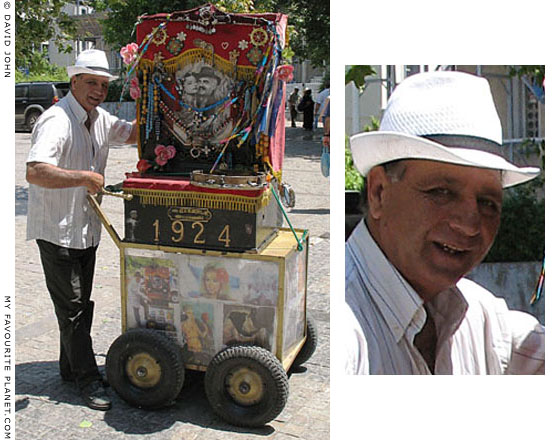
"It's then when the hurdy-gurdy man comes ..."
|
There are still a few of these guys pushing their vintage music machines around Athens. The mysterious wind-up noise-boxes are like secular shrines on wheels, adorned with baubles, bangles, bright-shiny beads and faded photos of Greek music and film stars of yesteryear. Kitschaphonic.
They no longer draw the crowds who used to gather to hear the latest sentimental melodies before the days of radio and i-pods. Now they are lucky if they can raise the curiosity of and a few coins from the passing groups of tourists as they rush between one ancient ruin and the next.
It's hardly the kind of occupation the next generation are likely to want to take up, but it may help a few senior citizens to supplement their meagre pensions.
Wonder what happened to his monkey? |
|
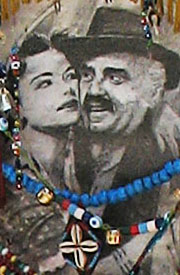
One of Athens' more
unusual icons, idols
of Greek showbiz. |
|
| |
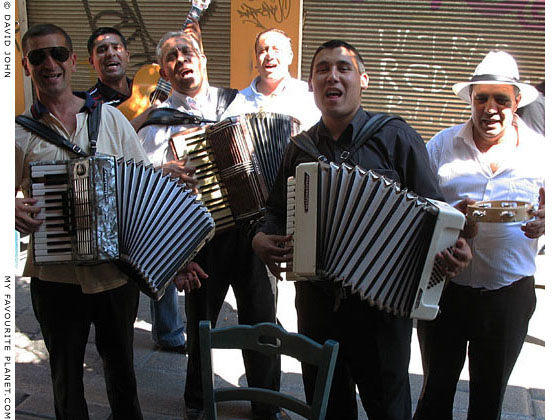
"That's the way you do it."
A family of Albanian street musicians sing from café to café
on a Sunday afternoon. They are actually pretty good,
funny too, and certainly brightened up my five minutes. |
| |
| |
Passa tempo |
 |
|
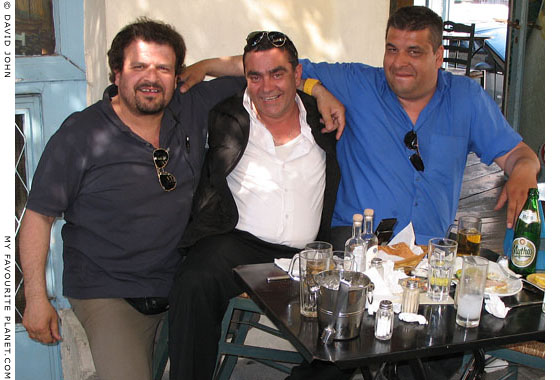
And here is part of the audience of the musicians above.
Three old friends meet for Sunday lunch at a small taverna
in Monastiraki. I had just decided to take a break from
my walk around town, and they invited me to join them.
Thanks, lads. Ya sas! |
|
Aspects of Athens

Put your mouse
over an image to see further details. |
| |

bouzouki beauty |
| |

traffic conductor |
| |
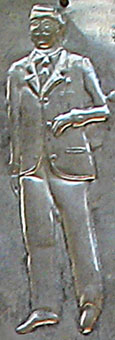
charm |
| |

low-flying
Sponge Bob |
| |

summer fashion |
| |
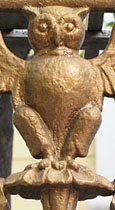
Schliemann's owl |
| |
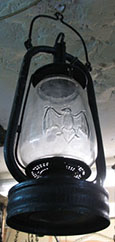
the bat lamp |
| |
| |
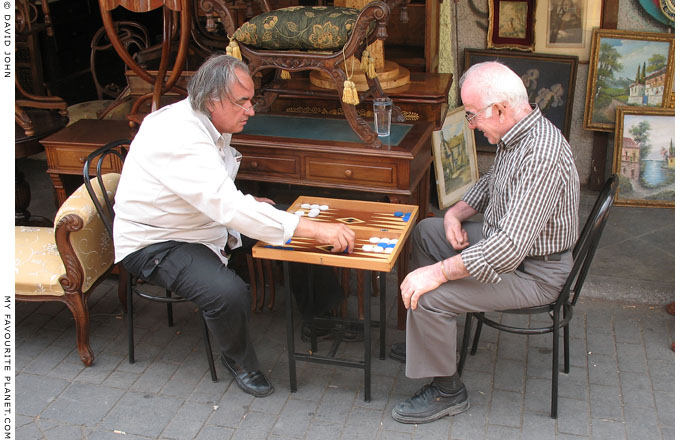
Two modern Athenians playing tavli (backgammon) at the Flea Market in Monastiraki. |
| |
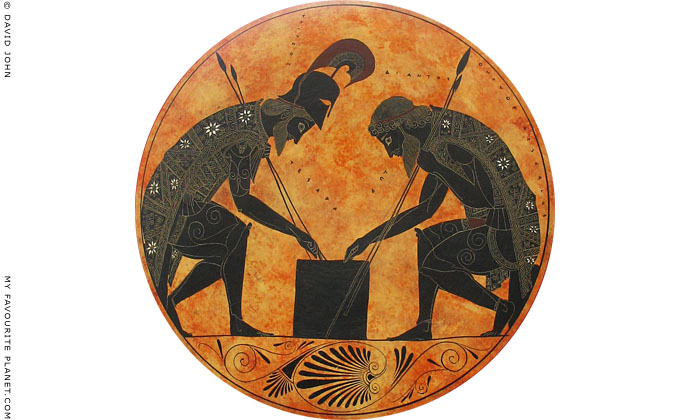
Two ancient Greeks playing a board game.
I'd love to tell you more about these ancient warriors, but we don't
want to get into all that history stuff right now, do we? Best wait
until this pic arrives at the My Favourite Planet guide to Athens. |
| |
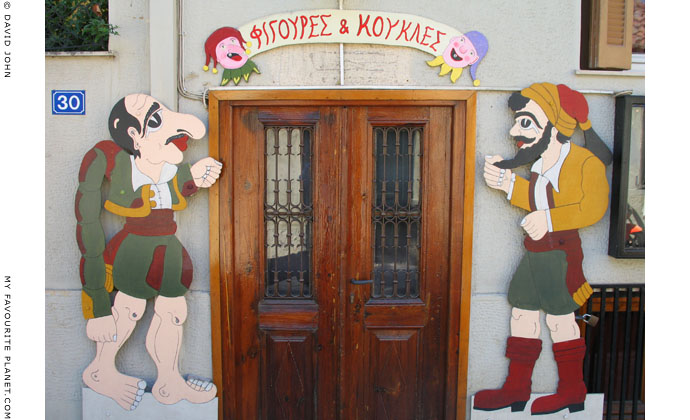
"I got no strings to hold me up, there are no strings on me."
|
"Figoures kai Koukles" (translated literally, Figures and Dolls) is the Athens home of the traditional Kariagozi shadow puppet theatre in the Plaka district. Kariagozi, the Greek equivalent of Punch or Punchinello, is loved by children for his outrageously tricky antics, and by adults for the wry satirical humour of the shows.
There are regular performances here and often in other parts of the city. Kariagozi also makes frequent appearances on Greek television. Even if you don't understand the Greek dialogue, it is well worth catching a show for the visual drama, the effect of the voices and background music, as well as the reactions of the audience. |
|
|
| |
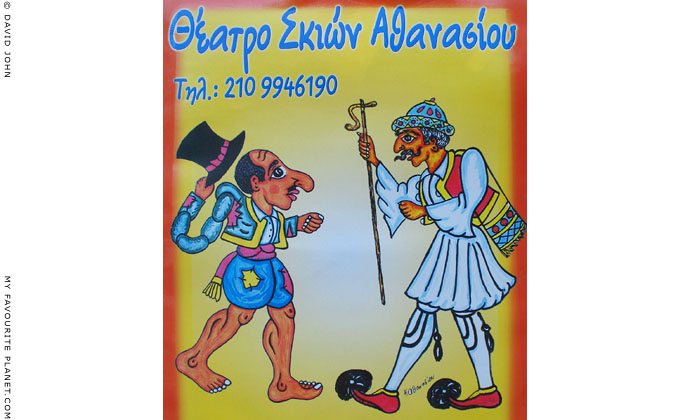
One of the posters to be found all around Athens, especially
outside schools, advertising Kariagozi theatre performances.
See further information about Kariagozi
shadow puppets at www.davidjohnberlin.de |
| |
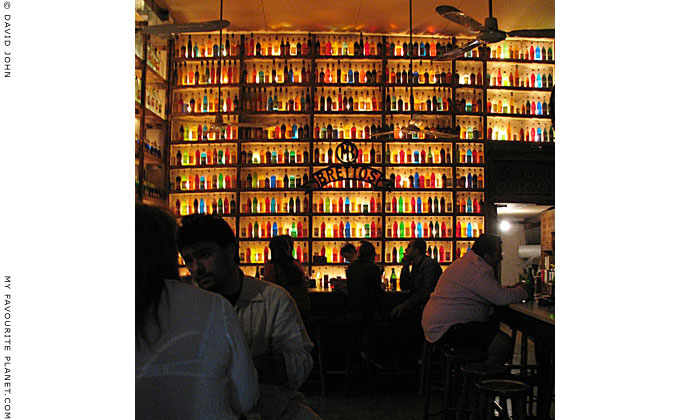
The Brettos Wine Bar in the Plaka.
|
The artist Francis Caruso, who has lived in Athens for many years, rightly points out that although thousands of tourists pass by Brettos wine bar every day, taking hurried snapshots of its interior from the doorway, few actually stop off here. A shame, perhaps, for them, but maybe a blessing for regular customers.
I can't remember how long Brettos has been here on the corner of Kydathinaion and Adrianou streets - forever probably. Over the years it has become an institution among Athenian bon-viveurs. I'm pretty sure, though, that this was the first bar anywhere to use backlit bottles and their colourful contents as a design feature, a simple but ingenious idea which has been copied worldwide. |
|
|
| |
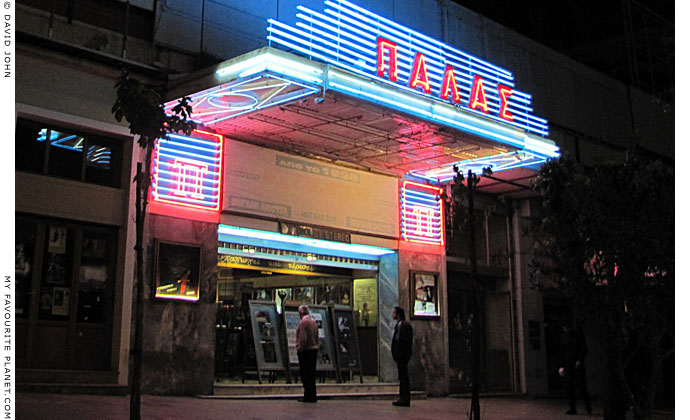
The Palas cinema, Pangrati, "Since 1925: only good films".
|
The Palas (Παλαs, Palace) is one of the oldest surviving cinemas in Europe that hasn't been converted into a multiplex or a supermarket. A splendid and inexpensive place to spend an evening. Despite its retro look, the seats are comfortable and it is equipped with modern technology, including genuine electricity and Dolby sound.
In Greece, films are often split into two parts, and a gong announces the "DIALEMMA", or intermission, during which the audience can go to the toilet, have a chat and buy drinks and snacks, in any order the wish. Greek pies and cakes are still at least as popular as popcorn. A very civilized type of cinema-going, and the revenue from the goodies sold during the interval helps these small cinemas survive.
Most foreign films are shown in the original language with Greek subtitles. This can be a bit of a problem for comedy films, as the subtitles for a punchline often appear on the screen just before the actor actually delivers it, and the Greek audience are already laughing so loud at the joke that you don't get to hear what is being said. You either have to learn Greek or go with a Greek friend with translating skills - and patience.
Many districts of Athens have such neighbourhood movie theatres, including outdoor cinemas - an even more civilized and pleasant way to see a movie between June and September. Pangrati's open-air cinema, Oasis, is about 3 minutes walk from the Palas.
UPDATE 2013
Athens cinema listings in English used to be published by the weekly The Athens News, but since the demise of the newspaper earlier this year I am no longer sure where such listings can be found. |
|
|
| |
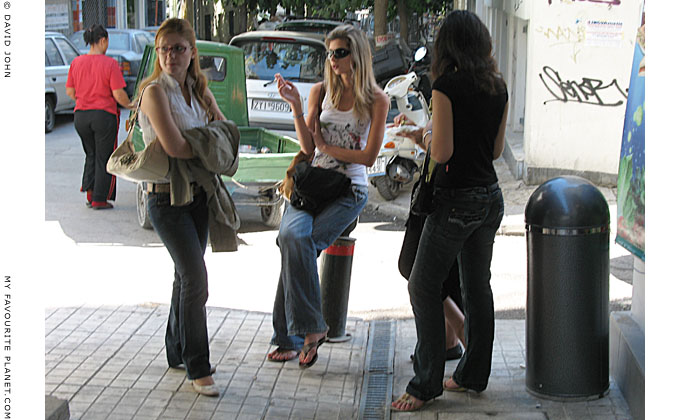
Another popular pastime: street-corner posing.
Not everybody can do it well, but some exponents of this ancient art are
naturally masterful. Here we see a young Athenian woman with a black belt
in posing giving a practical demonstration to her unintiated friends, who
carefully observe the effect of "crouching sphinx" on innocent passers-by. |
| |
| |
Welcome to the working week |
 |
|

Workers repairing Athinas Street in central Athens.
|
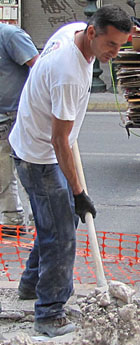 |
|
There's been a lot of talk in the world's media recently about "lazy Greeks", with pictures of people lounging around at street cafés and evidently demonstrating the old adage "work is just a four-letter word". This, of course, is a baseless calumny and ignorant floccinaucinihilpilification: Greeks love work as much as any other nation, i.e. not a lot.
"I love work, I could watch it for hours." Whoever originally said that deserves plenty of overtime.
Here is evidence of Greek road repairers earning a crust with sweat and toil. And this was during the heat of afternoon, when most sensible citizens of Mediterranean countries were enjoying a siesta. (Why is there no word in Greek for siesta?) They were working with energy and good humour to fix the pavement of busy Athinas Street in time for the arrival of crowds of evening shoppers. Get a move on, fellas, they'll be waking up in a couple of hours.
In Greece, as everywhere else in the world, there are those who work and those who have offshore bank accounts. |
|
| |
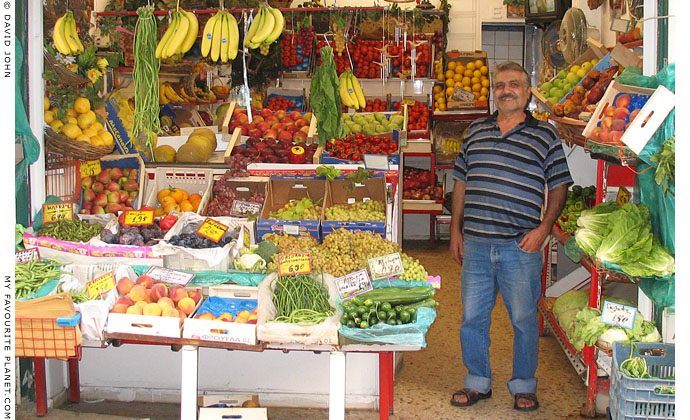
Venerable vegetables and formidable fruit at "Oporopoleion O Efthymios", Pangrati, Athens.
|
Another happy worker, a colourful costermoger, gregarious greengrocer.
Those peaches are fresh, tasty, juicy, but they cost over 5 euros per kilo. Since the economic crisis spread from the USA to Greece, prices having been leaping ever upwards. Before Greece became a full member of the EU, most people could afford to buy homegrown fruit and veg, whereas imported luxury goods, from dairy products to fruit juices (before Greece developed its own juice packaging industry), were expensive, particularly with import taxes of upto 150%.
During and after the military dictatorship (1967-1974) the import of some products, such as bananas (also, curiously, matches and playing cards), were banned altogether, to protect the balance of payments as well as local monopolies and industries. Strange how much Communism and Fascism have in common.
Now it seems things are the other way around, with products leaching into the economy through huge EU-based multinational chains undercutting smaller Greek firms who have been saddled with higher costs and new taxes. It all seems very topsy-turvy, especially in a country which could be self-sufficient in terms of food. It cannot be denied though, that many Greek businesses all along the supply chain are shamelessly taking advantage of the economic chaos by radically revising their mark-up, upwards naturally.
The kind of prices Athenians now have to fork out for food would have northern European shoppers rioting in the supermarket aisles, or more likely Twittering in their Twingos.
One wonders how long small shops like this one can hold out against the massive buying power and juggernaut sensitivities of Aldi, Lidl and co. In northern Europe and other parts of the world, such neighbourhood stores are closing down every week. Having said that, I have just heard that the big supermarket chains are not only halting their explosive expansion into Greece, but are even closing down stores. |
 |
|
| |
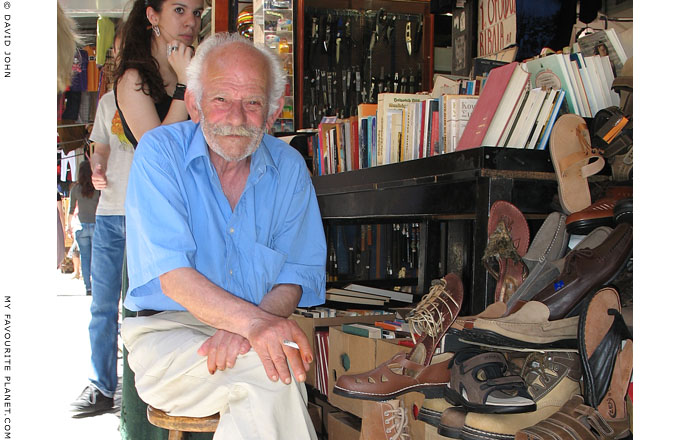
Sandal-maker in Monastiraki.
|
|
When this shoemaker was in his prime, Athens districts such as the Plaka, Psyri and Monstiraki were full of small, open-fronted workshops in which craftsmen made and directly sold a variety of wares from leather, metal and wood.
Such workshops can still be found in Africa and Asia, but they have totally disappeared from Greece. From the late 1970s it was considered that the working conditions, smells and noise did not fit into the concept of a "modern shopping experience". New laws and taxes also forced divisions between production and sales. The rough-and-ready workshops have become glass-fronted shops, mostly selling plastic tat imported from the Far East. Those firms which still actually make things themselves have moved production to larger industrial premises.
This is all undoubtedly more efficient, cost-effective, better for the workers, neighbours, tourists and the environment, and so on, but I do miss some of those sounds and smells, and the opportunity of watching a craftsperson at work. (Few people, of course, mourn the loss of local abattoirs, tripe factories or leather curers, or their noises and stenches.)
In some places crafts workshops have become tourist attractions in themselves, and visitors are often far more likely to buy products they have seen created. This kind of feature is ideal for crafts such as jewellery, pottery and carpet-making, but probably unsuited for fast-moving Athens, where most visitors come for a day or two, visit the ruins and museums, buy a flokati and a bottle of ouzo, then rush off to the next location on their vacation itinerary.
These days, our shoemaker leaves most of the work to younger family members and employees, while he chats with neighbouring shopkeepers and passers-by. The traditional Greek types of shoes, boots and sandals are no longer must-haves for tourists, and the shop has diversified into second-hand books, specialist knives and scissors and other paraphenalia. But if you venture into the shop's basement you will still find some of the arcane machinery once used to make footwear here. |
|
| |
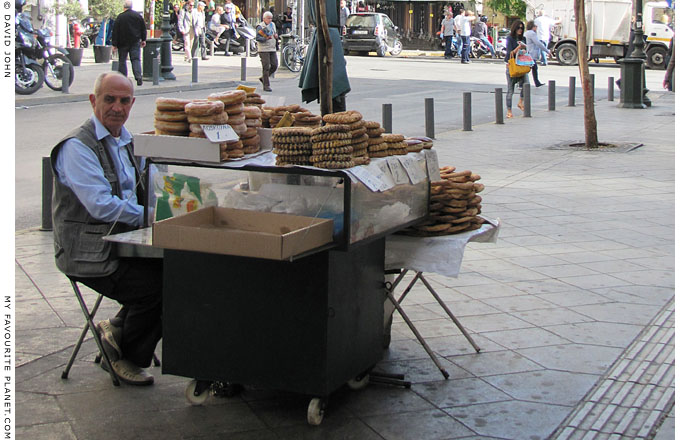
Feeling peckish?
|
Everywhere on the planet where there are streets you will find street vendors. It stands to reason that more of them are to be found in warmer countries, although adverse economic conditions force more traders out into the open in colder, so-called wealthier northern cities from New York to London, from Paris and Berlin to Moscow. In the aftermath of the most recent Asian economic crisis, bankrupt Thai millionaires found themselves selling sandwiches outside office blocks they used to run.
Mobility and next-to-zero overheads provide opportunites for baseline entrepreneurs to either make a living or climb up the slippery pole of ambition. The next step up in Athens is either a periptero (kiosk) or a small shop. For many people though, street vending is simply a profession in itself. Basta.
This pastry seller offers a range of calorie-bomb cakes and doughnuts, with flavours and fillings of chocolate, cream and cheese, to hungry shop and office workers, shoppers and people who just love these carbohydrate treats. He is dignified and quietly self-assured. He doesn't need neon signs or gimmicks to sell his wares, just hand-written labels with the name and price of the product. Most local people will know and trust him and the quality of what he has to sell - otherwise he would not survive here long. It's that simple.
See photos of street traders in Istanbul at:
Making a living, The Cheshire Cat Blog, 23 September 2010. |
|
|
| |
| |
Through a glass brightly |
 |
|
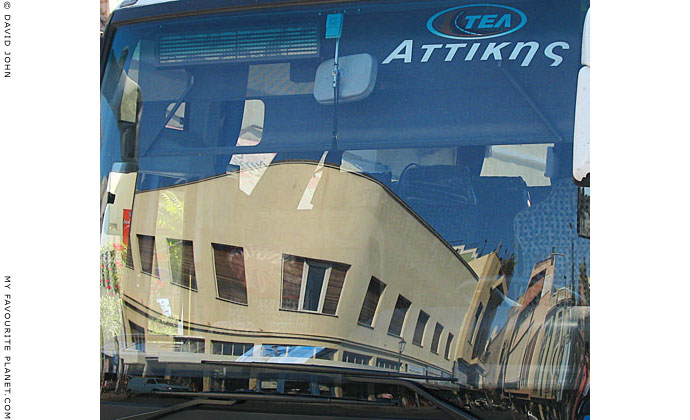
Please mind your head when leaving your seat.
Art Deco buildings of the Psyri district reflected in the
windscreen of a regional bus (Attica KTEL bus company).
File this under "arty", "atmospheric" or "self-indulgent"
according to taste and wind direction. |
| |
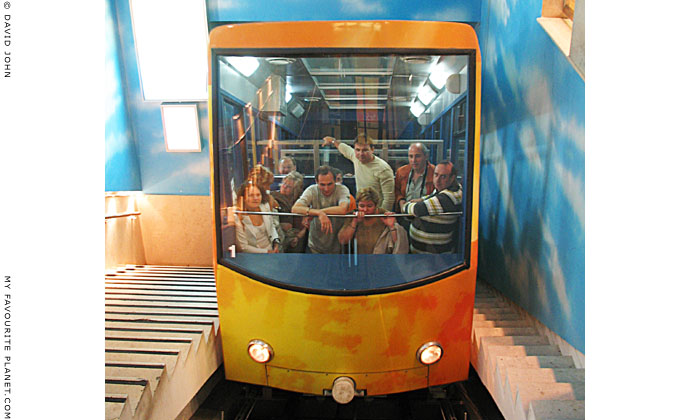
The "Telerifik" funicular train up to Mount Lykavittos.
|
I would really like to like the Telerifik. It is a good piece of engineering, and allows access for the disabled and not-so-fit to reach the highest point of Athens and enjoy the beautiful views over the whole city, including the Acropolis, and as far as the Saronic Gulf and the island of Salamis in one direction, and the surrounding mountains of Ymittos, Pendeli and Aegaleo inland. I never tire of these views.
There are many magnificent funicular railways in Euope - including the Snowden Railway in Wales and the Montmartre train in Paris, for which you can use a normal Metro ticket - but this is not one of them.
Unlike the other funiculars, the Telerifik tunnels through the hill's rock and is encased in concrete. This is discrete, but robs the passengers of the view and change in perspective offered by other hillside railways. They may as well have built an elevator. Somebody has done their best to brighten up the concrete walls with a mural of fluffy clouds, light panels have been added and the train itself has been painted yellow-orange (with subtle advertising for Metaxas brandy).
The 3 minute ascent costs 8 euros. This is obviously exorbitant by any standards. Unfortunately I have been unable to find out if there are any discounts for children or disabled people as the person responsible was indignant at being torn away from her gossip, was extremely rude and refused to answer any of my questions. So much for public relations. I was told, however, that it was forbidden to ascend the hill by the stairs either side of the railway (which would take an able-bodied person a couple of minutes) for "safety reasons" (in Greek safety and security are expressed by the same word), even though the train only goes every half hour.
Like most places in Athens, Lykavittos is not very disabled-friendly. The "able-bodied" tend to forget or ignore barriers unpassable for others. The top of the hill is covered with steps, stairways and steep slopes, challenging enough for feet, and unsuitable for wheelchairs.
Walking up the hill by one of the several winding paths from the Kolonaki district takes about 15-20 minutes. The super-fit can manage it in less. If you want to enjoy the perspectives as you go up, benches have been provided at various points to let you catch your breath, drink some water and wonder at the view. Take as long as you like, it costs nothing. The views are particularly spectacular in the light of sunrise or sunset, although at the latter the crowds can get overwhelming.
The restaurant on Lykavittos is not too expensive (menus are normally on display, or ask a waiter - no obligation or hard-sell). The service is impeccable, the food is well above average and it is a wondeful place for a romantic dinner with a view. |
|
|
| |
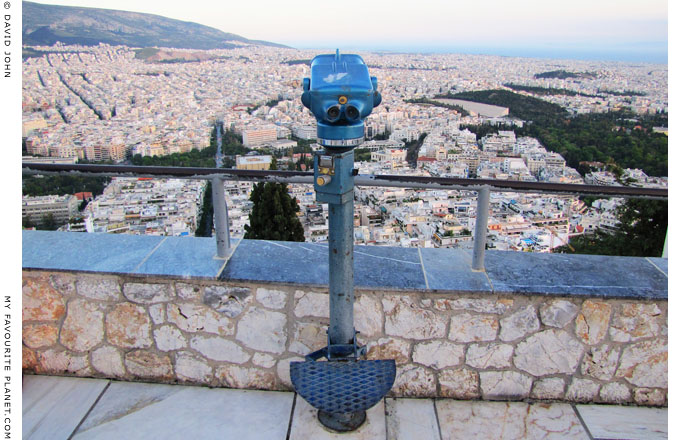
Clockwork binoculars on Lykavittos.
|
And here is one of the panoramic views from the top of 277 metre high Lykavittos Hill (or Mountain), looking southwestwards. To the left, the western end of Mount Ymittos (Hymettos) descends to Glyfada and the Saronic Gulf. Just to the right of the binoculars is the Panathenaic Stadium amidst a band of green which conitnues right in the National Gardens behind the Vouli (parliament) on Syntagma Square.
How do you spell the name of this hill? There are several ways in which the Greek name Λυκαβηττός is transliterated into the Latin alphabet - including Lycabettus, Lycabettos, Lykabettos, Lykavettos, etc., but Lykavittos is the closest to how it is pronounced by modern Greeks. And is it a hill or a mountain? It certainly towers above central Athens, and many other humps around the world under 300 metres high are referred to as mountains. Then again, compared to the 1,026 metre high Mount Ymittos to the south and Mount Parnitha to the northeast, which peaks at 1,413 metres, Lykavittos is just a mole hill on the Athenian plain.
These binoculars are distant cousins of the British Owl Telescopes (see The Owl and the Telescope - Part 1, The Cheshire Cat Blog, 7 October 2010). |
|
|
| |
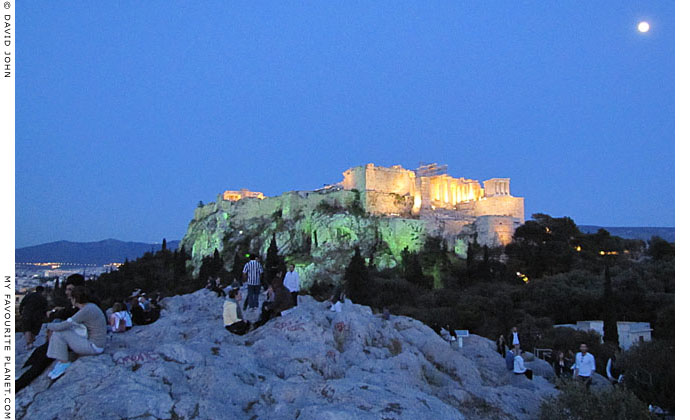
Moonlight over the Acropolis and Areopagus Hill.
|
The Areopagus is also not to be sneezed at as a hill. Although only 115 metres above sea level, this enormous lump of limestone provides wonderful views of the Acropolis to one side, and the Ancient Agora, the Pnyx and other sights to the other.
Perched on this rock in antiquity were an administrative assembly, a law court for murder cases and the barracks of a police force made up of Scythian bowmen. There is not much to be seen of these ancient institutions today. Saint Paul the Apostle is also said to have preached here.
Over the centuries the rocks have been worn ultra-smooth, and it is one of the slipperiest surfaces your feet are likely to encounter outside an ice rink. Sturdy footwear and extreme caution are advised, especially after dark - there is no lighting up there.
The wonders of the Areopagus at night used to be an Athenian insider tip. Courting couples and small groups of friends stole up here to watch the sunset and enjoy the evening light. But now that the secret is out, the place can get pretty crowded on summer evenings. Still, the atmosphere is usually quiet, friendly and relaxed. |
|

warning sign on
the Areopagus:
"Caution!
Slippery surface" |
|
| |
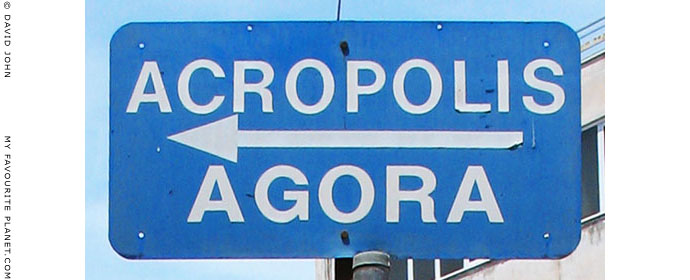
This way to the Acropolis.
Click on the photo to go to the new My Favourite Planet Acropolis photo gallery.
Our section on the Ancient Agora is due to be published in the near future. |
Articles and photos by David John copyright © 2007-2011
The Cheshire Cat Blog at My Favourite Planet Blogs
We welcome considerate responses to these articles
and all other content on My Favourite Planet.
Please get in contact.
The photos on this page are copyright protected.
Please do not use them without permission.
If you wish to use any of the photos for your website,
blog, project or publication, please get in contact.
Higher resolution versions are available on request. |
 |
Visit the My Favourite Planet Group on Facebook.
Join the group, write a message or comment,
post photos and videos, start a discussion... |
|
Views of blog authors do not necessarily reflect those of the publishers
or anyone else at, on or in the vicinity of My Favourite Planet. |
 |
| |
|
|
| |
| |
 |
| |
 |
| |
 |
| |
 |
| |
 |
| |
 |
| |
George Alvanos
rooms
in Kavala's historic Panagia District
Anthemiou 35,
Kavala, Greece
kavalarooms.gr |
| |
| |
Olive Garden Restaurant
Kastellorizo,
Greece +30 22460 49 109
kastellorizo.de |
| |
| |
Papoutsis
Travel Agency
Kastellorizo,
Greece +30 22460 49 286
greeklodgings.gr |
| |
| |
|